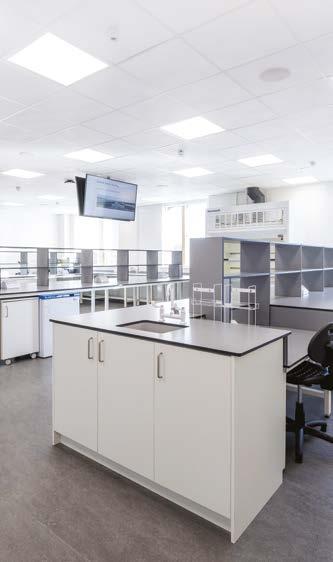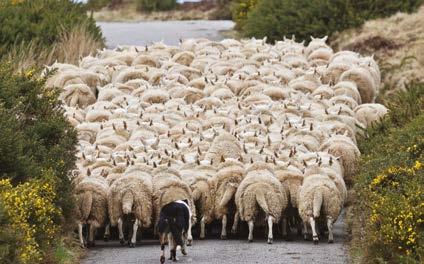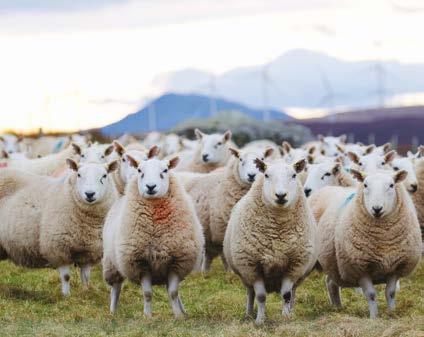Introducing RAVIC

The Rural and Veterinary Innovation Centre (RAVIC) in Inverness is SRUC’s new £12.5m facility developing collaborative, high value links with business.
By collocating SRUC research, teaching, veterinary and consultancy services, excellent facilities and infrastructure, and commercial businesses and entrepreneurs, RAVIC creates opportunities to realise new business, technology, product, and service innovations.
Far more than simply a business incubator, RAVIC's mission is to help drive growth through collaborative enterprise and innovation for Scotland's health, agriculture, and aquaculture industries.

5
Onsite expertise
RAVIC, part of the SRUC School of Veterinary Medicine, provides a base for SAC Consulting and SRUC Veterinary Services across the North of Scotland and is home to SRUC’s Centre for Epidemiology and Planetary Health Research (CEPH).



CEPH engages in world class agriculture and aquaculture research and is a centre for excellence in veterinary health surveillance, molecular epidemiology, data science, microbiology, public health and zoonotic disease.
SAC Consulting provides independent, research-driven, industry-leading expertise, advice and solutions for agricultural, food, and land-based businesses – and has been trusted to do so for decades.
Discover what SAC Consulting can do for you.


SRUC Veterinary Services is the main provider of UK livestock health and surveillance services, analysing over 1 million samples for around 7300 farmer and livestock members each year.
Explore SRUC Veterinary Services.
7
Cultivate your potential
Accessing RAVIC is easy, with options including virtual membership through to onsite hot desking and five fully serviced business tenancy units.
All RAVIC members can access onsite expertise and infrastructure including Centre for Epidemiology and Planetary Health researchers, SRUC veterinary services, and SAC Consultants as well as fully equipped laboratories, meeting rooms, a 55 seat lecture theatre, and ample collaboration and networking spaces located throughout the 1750m² facility.
Members can additionally access SRUC's nationwide network of experts in agriculture, animal health, food and drink, natural capital, conservation and climate, and veterinary medicine to name just a few.


Virtual membership
• Minimum monthly fee, low barrier to entry
• For entrepreneurs, new start businesses, SMEs
• Ideal for intermittent access to RAVIC facilities and expertise
Hot desking
• Up to 8 desks available in a communal office
• Provides a flexible, secure base of operations
• Daily or monthly hire options are available


Tenancy
• Five fully serviced, secure business units
• For those requiring larger space and regular building access
• 6 month+ lease options available, with 24/7 entry
9
9
What’s inside
Ground Floor







10
3x Meeting rooms
55 seat lecture theatre
Large open atrium
Café Space Necropsy
Suite








11
CL2 Microbiology Lab
5 x 25m² Tenancy Units
Hot desking office
Molecular Lab
Multipurpose Lab
Where we are
RAVIC is ideally located on the Inverness Campus, with direct road, rail, and air links to major UK and European cities.
RAVIC complements the vibrant, thriving life sciences sector already established in Inverness, providing synergies between regional businesses and national partners looking to develop activity in the region.


Inverness Campus also forms part of the Inverness and Cromarty Firth Green Freeport, whose primary objective is to maximise local benefits through creation of ‘Free Trade Zones’ that promote international trade, investment, regeneration, and innovation.








Inverness Train Station & Airport 15 minute drive London Amsterdam Belfast Edinburgh Glasgow Aberdeen 1 Hour 1.5 Hours 45 Mins 3 Hours 3 Hours 1.5 Hours 13
Case study: Supporting Scotland's BVD Eradication Scheme

BVD IS ONE OF THE MOST SERIOUS CATTLE DISEASES, COSTING UK FARMERS UP TO £61M PER YEAR*
THE CHALLENGE
Bovine viral diarrhoea (BVD) is a serious, highly contagious cattle disease impacting milk and beef production worldwide. Historically, BVD has affected 40% of Scotland’s 1.4 million beef and dairy cattle, causing reduced milk yields, increased disease susceptibility, slower growth rates, and increased abortions. Based on voluntary disease surveillance and testing programmes introduced by SRUC, in 2010 the Scottish government committed to eradicating BVD through a scheme involving routine screening, vaccination, and movement restrictions.
THE PROJECT
To support Scotland’s BVD eradication scheme, SRUC established new nationwide testing protocols that were accurate, reproducible, and scalable to deal with high sample volumes of up to 1 million tests per year. This high volume data science approach was combined with epidemiological modelling, economic analysis, and social science to underpin Scottish testing strategies, articulate values in real monetary terms, and improve farmer adherence and farm management practises.

*bvdfree.org.uk 14

OUTCOME
Since the launch of Scotland’s BVD eradication scheme rates have fallen from over 40% to under 10% today, resulting in savings of up to £110m to consumers and £370m to farmers and livestock keepers. SRUC research, data science, and analysis has underpinned the scheme’s success, including demonstrating the need for larger and more comprehensive testing as BVD prevalence fell. This work has contributed to SRUC being awarded a Queen’s Anniversary Prize for Higher and Further Education, the highest form of recognition open to educational institutions in the UK.

“
This research has not only identified problems but has been a catalyst for evidence-based change which has strengthened the BVD eradication programme in Scotland.
MR NIGEL MILLER, CHAIRMAN OF LIVESTOCK HEALTH SCOTLAND
PARTNERS







15
”
Case study: Epidemiology of Gill Disease in Scottish Farmed Salmon
SCOTTISH SALMON IS THE UK’S TOP FOOD EXPORT, WITH SALES WORTH £578M ANNUALLY*
THE CHALLENGE
Gill disease is one of the greatest threats to the Scottish salmon industry. Although there are many infectious and noninfectious causes of gill disease, it is challenging to link cases of gill disease to causative agents. Thus epidemiology research is needed to better understand risk factors, develop technologies to aid diagnosis, and establish models that enable new treatment options.
THE PROJECT
This project, started in 2018, was the first large scale study of salmon gill disease epidemiology in Scotland. Led by SRUC, it created an industry-wide collaboration including nearly all Scottish farmed salmon producers. Historical datasets and biweekly sampling assessed many different aspects of gill disease including risk factors, molecular and biochemical biomarkers, and impacts on productivity. Decision support tools were developed and made accessible to all partners and the scientific findings shared widely through publication.

* Salmon Scotland website
16

OUTCOME

The project has validated suspected gill disease risk factors and biomarkers, quantified diagnostic test performance and sample size requirements, and supported evidence based decision-making to better manage Salmon health. In addition, the collaborative network the project established provided a strong basis for further partnership activities benefitting Scottish aquaculture. The project also established a precedent for sharing large, commercially sensitive datasets, providing a framework for future innovation.
PARTNERS




This work is unprecedented, and we value the efforts put in by all partners. The project nurtured the importance of evidence-based decision making, one of fish farming management’s pillars.
“ ”
DAVE COCKERILL, HEAD OF BIOLOGY, BAKKAFROST SCOTLAND



17
Case study: Detecting Harmful Bacteria in Food and Livestock
FOODBORNE PATHOGENS CAUSE
MORE THAN 16,000
HOSPITALISATIONS PER YEAR IN THE UK ALONE*
THE CHALLENGE
Shigatoxigenic Escherichia coli, (E. coli) or STEC for short, are a group of bacteria mainly transmitted through contaminated food and infected livestock that can cause serious illness in humans. One of the big problems is that infected animals normally don’t show signs of illness, so there is no way of knowing the level of risk they pose. A further problem is that STEC are constantly evolving to new and potentially more harmful varieties. Thus, there is a need for surveillance methods to monitor which animals are infected, and genetic analysis to understand how these bacteria are changing over time.
THE PROJECT
At SRUC, we take the problem of STEC very seriously, and conduct surveillance on farms, in the environment, and with consumer products.
Recently we’ve investigated a new genetic test to identify the type and abundance of STEC in food and livestock, which we’re now exploring as a rapid diagnostic.

We’ve focused on genetic components that are associated with serious disease, using artificial intelligence (AlphaFold - alphafold. ebi.ac.uk) to analyse very large datasets and identify gene targets that would be suitable as diagnostics.
Food Standards Agency
*2020
18

OUTCOME
Our ongoing surveillance is a key step in preventing transmission of the pathogens into the food chain, and analysing STEC genetics using artificial intelligence has helped us assess molecular targets that could identify infected livestock and foods more rapidly and accurately.

Since meat hygiene starts with animal husbandry, cooperation throughout the food chain is a central element of risk based approaches to managing food safety. “
PROF GEORGE GUNN, DIRECTOR OF RAVIC
PARTNERS



19
”





RAVIC 9 Inverness Campus Inverness IV2 5NA Enquiries
Adam Giangreco Head of Business Development ravic@sruc.ac.uk +44 (0) 7818 011508 tinyurl.com/bdhzj8jr Supported by
Dr




















































































